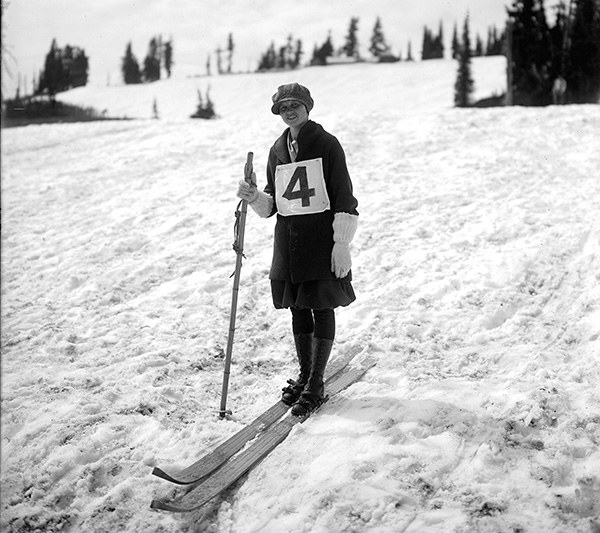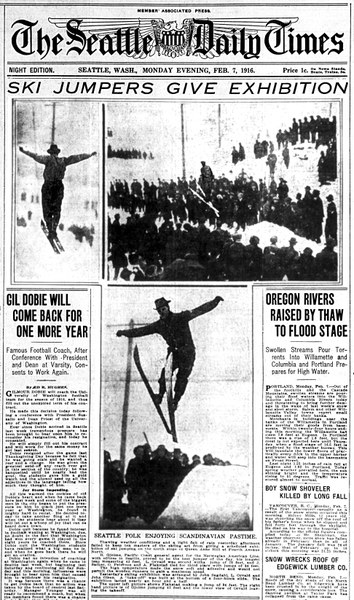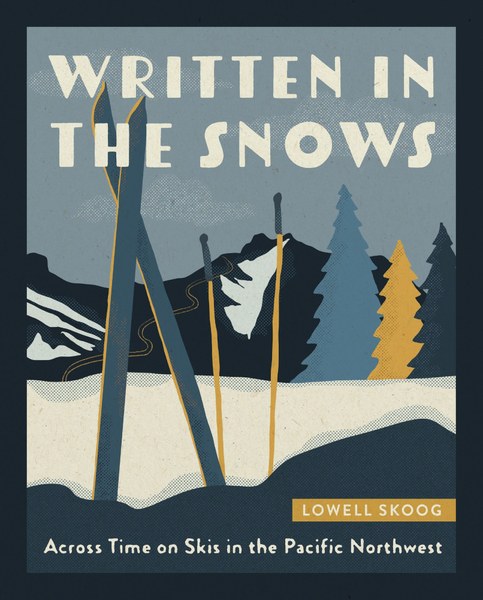
Written in the Snows: Across Time on Skis in the Pacific Northwest, new from Mountaineers Books, offers a definitive and visually rich history of the past century of Northwest ski culture.
In his debut title, renowned local skiing historian Lowell Skoog traces the development of skiing in Washington from the late 1800s to the present, covering the beginnings of ski resorts and competitions, the importance of the Olympic and Cascade mountains, and the friluftsliv, or open-air living spirit, of backcountry skiing. In this excerpt, experience how a record-breaking snowfall in 1916 led to the first-ever ski jumping tournament in the Pacific Northwest.
Excerpt from Chapter 2: The Big Snow
With its maritime climate, Seattle rarely gets much snow in winter. Snow in town is a novelty that quickly becomes a nuisance because of the city’s steep hills and limited ability to clear them. Scandinavians who grew up skiing and who settled in Seattle in the early 1900s were frustrated because snow never lasted long enough to encourage development of the sport here. But events in the winter of 1916 began to change this. That January was unusually cold. Lakes around the city froze over, and during the last weekend of the month, three thousand skaters flocked to Green Lake on a Sunday afternoon.
Over a period of three days, 29 inches of snow blanketed the city. The one-day record for snowfall in Seattle, 21 1/2 inches, was established on February 1. At 10:00 a.m. that day, the grandstand at the University of Washington’s Denny Field buckled under the weight of new snow. The following afternoon, the dome of St. James Cathedral collapsed. Newspapers reported similar cave-ins all around western Washington. Streetcars were disabled and five-foot drifts clogged residential streets. The Smith Tower, the tallest building in the western United States at the time, hurled rooftop avalanches onto pedestrians below. The Seattle Times reported that the city was “in the Clutch of the Snow King.” As Seattle slowly dug itself out during the days that followed, Times editorials exhorted citizens to “clean your sidewalks!” and “clean off that roof!” and “clean out the alleys.”
By the end of the week, odd tales of citizens coping with the snow were widespread. The Seattle P-I ran a fanciful account of one Henry Steinkopf, who wrote, “For fifteen years I have enjoyed the reputation of being the model citizen of our neighborhood… perfectly lamblike except under great provocation.” Steinkopf, who had never skied before, was persuaded by his Norwegian neighbor to borrow a pair of skis for a trip to the grocer. During the downhill run for home, he lost his groceries, his watch, his cash, and his temper after crashing into Rev. Mr. Lukenwater, the local pastor. “I repeat,” he wrote to the P-I editor, “that I lost all that was dear to me save my family because of those deceitful skis.” The story distilled through humor what non-Scandinavians imagined might happen if they tried skiing.
On Sunday, February 6, the Times printed an unusual announcement: “Ski jumping and speed skiing today will be introduced to the Seattle public… The committee in charge of the event believes that this is the first display of ski jumping ever staged in Seattle.” Three men worked late Saturday night to prepare a ski jump on Fourth Avenue North, one of the city’s steepest streets, in the Queen Anne neighborhood near the Fremont Bridge. “The contest Sunday,” explained organizer John Sagdahl, “is in the nature of an experiment. For many years, a number of ski jumpers from Norway who are now businessmen here have been attempting to create interest in the sport without success. We believe that skiing is one of the most thrilling sports in existence, both from the skier’s and spectator’s viewpoint.”
The event was an expression of the distinctly Norwegian ideal of friluftsliv, loosely translated as “open-air living.” Growing up where snow and skiing were a way of life, the ski-jumpers-turned-businessmen pined for snow-covered hills and the sport of their youth. A once-in-a-lifetime dump of snow in the city was simply too wonderful to waste. The ski jumping exhibition was front-page news on Monday. Warming temperatures, light rain, and sticky snow failed to deter ten jumpers from competing. Reidar Gjolme, general agent of the Norwegian American (steamship) Line, won the event with a leap of 43 feet. L. Orvald was second with 38 feet, and three jumpers tied for third.
The snow didn’t last long enough for a planned second exhibition. A rapid thaw flooded Northwest rivers, and the Great Northern Railway cancelled its trains through the mountains due to avalanche danger. Life in the city returned to a soggy routine. For the men who participated in the exhibition, however, the event stirred powerful memories of their skiing youth. In the months that followed, they discussed how they might revive ski jumping and put it on a firmer footing in the region. By the next winter, they had a tentative solution.
Seattle newspapers announced in February 1917 the “First Ski Tournament Ever Held in the Northwest” at Scenic Hot Springs, on the Great Northern line below Stevens Pass. In addition to mineral baths and “an invigorating atmosphere,” Scenic offered skis and toboggans for guest use on a small slope carved out of the forest behind the hotel. Five silver cups were put up for the event, with contests for both men and women. The Great Northern Railway offered a special two-dollar-and-eighty-cent roundtrip rate for the tournament. About 150 people traveled from Seattle to watch the tournament.
Nineteen skiers entered the event, traveling from Seattle, Tacoma, and even Victoria and Vancouver, British Columbia. They included Thor Bisgaard of Tacoma and the winner of two previous winter’s competitions in Seattle, Reidar Gjolme, who had competed on the famous Holmenkollen jump in Norway in 1902. Jumps of 80 to 100 feet were expected, although the newspapers acknowledged that “some of the men who will compete have had many seasons pass their heads since they essayed the flight through the air on skis.”

the front page of the Seattle Times on February 7, 1916 featured ski jumpers (clockwise from upper left): A. Flakstad, Reidar Gjolme, and L. Orvald.
The tournament on February 4 was marred by rain and sticky snow. Gjolme won the meet with jumps of 70, 76, and 72 feet. Birger Normann of Tacoma was second. Due to the difficult conditions, Normann was the only jumper to stand up after his leaps. The highlight of the tournament was a young Norwegian woman, twenty-four-year-old Olga Bolstad, who arrived during the event and asked to borrow a pair of skis. “Although an unknown when she arrived,” newspapers reported, “she speedily became the most talked-of person in the tourney, owing to her sensational jumping.” Bolstad cleaned up the women’s prizes and was awarded honorable mention in the men’s events for her jumping.
Organizers realized that Scenic Hot Springs was not an ideal location for skiing. At an elevation of only 2,200 feet above sea level, Scenic receives as much rain in winter as snow. Fortunately, Bisgaard knew another option - Mount Rainier - as well as any skier. He had attended The Mountaineers’ New Year’s outing at Paradise just five weeks before the Scenic tournament and knew that the Paradise Inn would open to the public that summer. At an elevation of 5,400 feet, Paradise often holds snow into July.
After meeting with Thomas H. Martin, proprietor of the new inn, Bisgaard organized an event unprecedented in America: a midsummer ski tournament. The tournament was scheduled for July 29, 1917. Paradise Inn opened before the road was cleared of snow, and the first guests saw their baggage delivered on sleds. Publicity for the event announced that Olga Bolstad, “the most sensational lady ski-jumper in the Northwest,” would be competing.

Written in the Snows is available for purchase at our Seattle Program Center bookstore, online at mountaineersbooks.org, and anywhere books are sold.
This article originally appeared in our Winter 2022 issue of Mountaineer Magazine. To view the original article in magazine form and read more stories from our publication, visit our magazine archive.
 Lowell Skoog
Lowell Skoog